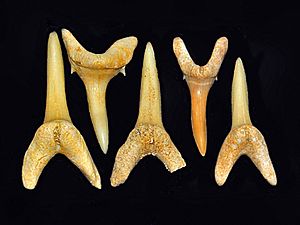Striatolamia facts for kids
Quick facts for kids Striatolamia |
|
|---|---|
 |
|
| Fossil teeth of Striatolamia whitei from Khouribga (Morocco) | |
| Scientific classification |
|
| Kingdom: | Animalia |
| Phylum: | Chordata |
| Class: | Chondrichthyes |
| Order: | Lamniformes |
| Family: | Odontaspididae |
| Genus: | †Striatolamia Glikman 1964 |
| Synonyms | |
|
|
Striatolamia was a type of shark that lived a very long time ago. These ancient sharks are now extinct, meaning they are no longer found on Earth. They were part of a shark family called Odontaspididae, often known as sand sharks. Striatolamia sharks swam in the oceans from about 61.7 million years ago (during the Early Paleocene period) until about 10.3 million years ago (in the Late Miocene period).
Contents
What Does the Name Mean?
The name Striatolamia comes from Latin words. "Striato" refers to the striations or tiny grooves and lines found on the surface of their teeth. "Lamia" is a common ending for shark names, often linked to a type of mythical monster or large fish. So, the name basically means "striped shark" because of its teeth!
Types of Striatolamia Sharks
Scientists have identified several different kinds, or species, within the Striatolamia group. Here are the main ones:
- Striatolamia macrota Agassiz 1843
- Striatolamia striata (Winkler 1874)
- Striatolamia whitei (Arambourg, 1952)
Some other shark groups, like Carcharoides, Parodontaspis, and Synodontaspis, are similar to Striatolamia.
How Big Were They?
Striatolamia sharks could grow quite large! Some species might have reached lengths of about 350 centimeters (which is about 11.5 feet). That's longer than a typical car!
What About Their Teeth?
One of the most interesting things about Striatolamia is their teeth. Their teeth are often found as fossils and are quite big. They are also very common in ancient ocean sediments.
The teeth at the front of their mouths were long and pointy. They had those special grooves, or striations, on the inside surface. They also had small, sharp points on the sides, called cusplets. The teeth located further back in their mouths were a bit smaller and wider, with less noticeable grooves.
There were some differences between the teeth of different Striatolamia species. For example, the front teeth of S. macrota had smaller roots than those of S. striata. Also, S. macrota teeth were often curved. The length of their teeth also varied: S. striata teeth were generally smaller (13 to 51 millimeters) than S. macrota teeth (19 to 38 millimeters).
Where Did They Live?
Fossils of Striatolamia sharks, mostly their teeth and fossilized backbones, have been discovered all over the world. The most common species found are S. striata and S. macrota.
These ancient sharks preferred to live in waters that were not very salty. This means they likely lived in coastal areas, like estuaries or shallow seas, rather than the deep, open ocean.

